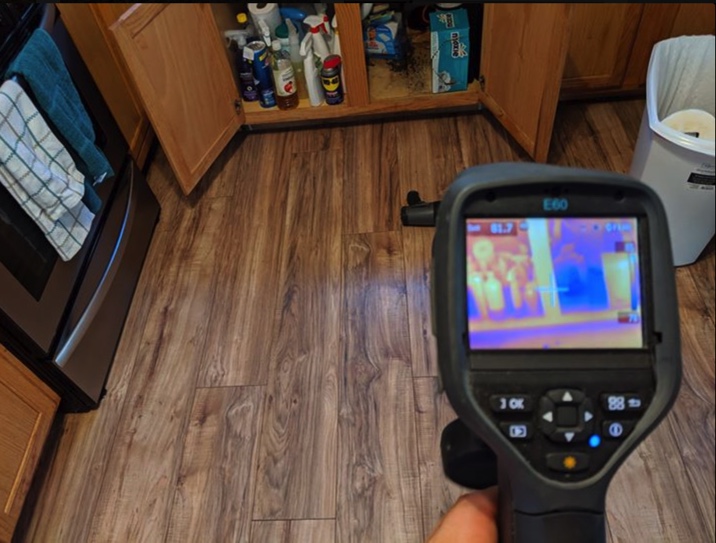This is a sponsored post. All opinions are my own.

What is Indoor Air Quality?
When I think of home improvement, I usually think about aesthetic projects like painting a room, remodeling the kitchen or getting new flooring. Now that I’m spending more time at home, I’m realizing that home improvement is much more than just making updates to interior design.
Your home should be your oasis, and in times like now, you should feel safe and healthy inside your house. Just as we are taking steps to protect ourselves from germs, viruses and pollutants when we leave our house, thinking about what’s inside our house can help us stay well, too.
What do I mean? According to the U.S. Environmental Protection Agency (EPA), indoor air quality refers to the quality of air inside and around buildings that can affect the health and wellbeing of occupants. Indoor air pollutants can cause short and long term health effects.
Short-term effects to indoor air pollutants can vary greatly from person to person based on exposure and that person’s sensitivities. These can include itchy eyes, runny nose, scratchy throat, headaches, dizziness and fatigue. Since these symptoms can be similar to those of the common cold and other viral diseases, it’s important to note if the symptoms fade or go away when you leave a certain area. This may be an indicator of an indoor air pollutant.
Long-term effects to biological or chemical indoor air pollutants could include respiratory illnesses, heart disease and cancer. While these can be debilitating or deadly, sometimes symptoms take years to show up. It’s important to be mindful of indoor air quality to prevent chronic illness later.
What can Affect Indoor Air Quality?
I have suffered from allergies throughout adulthood, but I typically experience them the most in the spring and fall months. As we are spending more time at home, I have days where I feel like my allergies are acting up, so I’m doing more research on what this could mean. Sometimes I wake up with itchy eyes or a scratchy throat. Of course, my first thought is the worst – we are living through a pandemic and that is always going to be top of mind!
As I’ve been doing more research, though, I realized that our air quality may need some improvement. Several factors can affect indoor air quality, including both biological and chemical sources. These can include appliances, tobacco products, certain building and furnishing products, household cleaning products, certain personal care items, heating/cooling systems, excess moisture and outdoor pollutants.
Ventilation is another key factor for indoor air quality. If there is inadequate ventilation throughout a home, pollutants can build up and cause serious health threats. Proper ventilation depends on the source of the pollutant, but you can circulate indoor and outdoor air through windows and doors, as well as vents. Indoor air can be circulated with fans, filters and other installed ventilation devices.
How to Improve Indoor Air Quality
If you are experiencing symptoms such as irritated eyes, nose or throat, headaches or fatigue, and you are not sick, it may be time to investigate your home for indoor air pollutants.
Here are some ways that indoor air quality can be remedied at home:

Dust and pet dander
First, it’s always a good idea to clean the house as often as possible. Dust and pet dander can be a cause for respiratory irritation. I definitely need to clean more often since we adopted our pup!
Cleaning products
Be mindful when cleaning as many chemical cleaning products can also cause these symptoms. If you find you’re keeping up with cleaning but don’t feel well when cleaning or directly after, switch out your cleaning products, perhaps for a natural alternative.
Open windows when possible
Opening windows can help circulate in fresh air to mediate indoor air pollutants. It’s tough during the hot summer months, but I can always tell the difference in our air quality when we have the windows open.
Clean filters
If your heating or cooling unit uses a filter, make sure to switch out old filters for new when necessary. Also, check other appliance filters, such as your stove fan, vacuum canister and dryer vents.
Call a professional
If you’ve done all of the above and are still having symptoms, call a professional for a home assessment. For New Jersey residents, Nash Everett is a local indoor air quality company that specializes in mold removal in Marlboro. They also provide duct cleaning, moisture management and ventilation expertise.

Final Thoughts
Your health and wellbeing are a top priority, especially inside your home. You should never feel worried that your indoor air quality could make you sick, now or in the future. By taking steps to assess your air quality and to improve it, you can greatly reduce your risk for short- and long-term health effects.
Although not all indoor air pollutants can be seen or smelled, there are ways to prevent diminished air quality from affecting you. If you have cleaned, updated cleaning products, ventilated and switched out old filters, and you are still experiencing symptoms, it may be time to call a professional.
Have you ever experienced poor indoor air quality? What did you do to remedy your home? Let me know in the comments below.
Thank you for the tips! My children’s allergies have been going crazy lately, so we got a carpet cleaning to help cut down on the dust. I’m going to replace our air filters to help as well!
Great info! We considered air quality when we chose to go with foam insulation for our remodeling project. A measurable improvement for sure. Just another way to address overall indoor air quality!